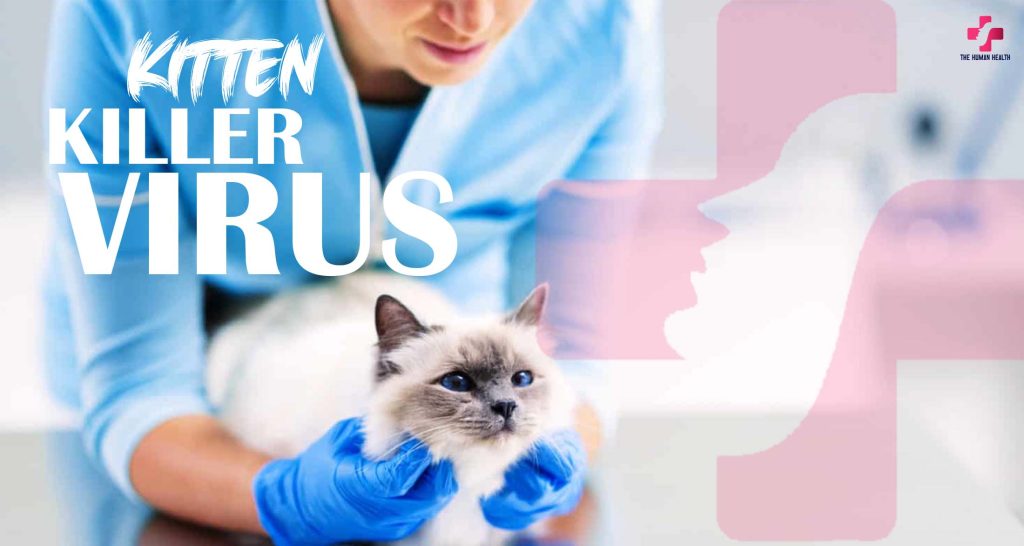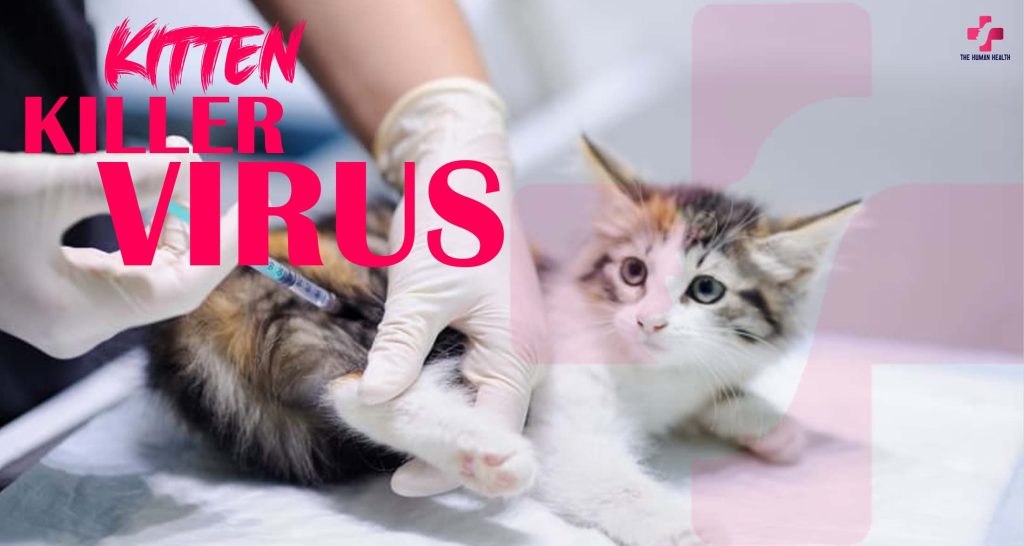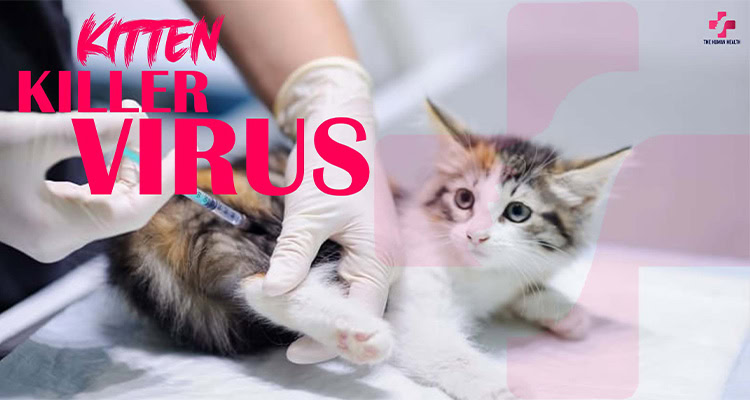Introduction to Kitten Killer Virus
Some viruses spread fast and make animals sick. One virus that hurts cats is the Kitten Killer Virus (KKV). It spreads quickly and makes kittens very sick. Experts are still studying where it came from, but cat owners and vets are worried.
KKV is a strong type of feline calicivirus (FCV). Unlike other FCV types, this one is worse. It mostly affects breathing and digestion. Kittens and weak cats often do not survive
How It Spreads
The first KKV cases appeared in shelters and places with many cats. Scientists think it may have started as a stronger version of another virus. Some believe it came from another species or changed in a lab.
Cats catch KKV by touching sick cats or objects. The virus spreads through saliva, mucus, pee, and poop. Bowls, blankets, and hands can carry it. It can also spread through the air, making it hard to stop.
Symptoms and Effects
KKV spreads fast and makes cats sick quickly. Signs appear in two to five days. Early symptoms include fever, tiredness, and trouble breathing. As it gets worse, cats may get mouth sores, bleeding, and dehydration. Some have seizures, which means the virus has reached the brain.
Unlike other FCV types, KKV does not just cause small breathing problems. It leads to organ failure and weakens the immune system. Since it spreads fast, early quarantine helps stop outbreaks.
Impact on Cats
KKV has harmed many cats, especially in shelters and feral groups. Most kittens do not survive. Even adult cats rarely get better, and those that do often stay sick.
KKV changes quickly, so current FCV vaccines do not work well. Scientists are working on new treatments, but there is no cure yet. Possible solutions include antiviral drugs, immune boosters, and breeding stronger cats.
Conclusion
KKV is a deadly virus that spreads fast and is hard to stop. The best way to protect cats is through early detection and clean spaces. Scientists are still working on ways to fight it. Future research may help control or even remove this virus.
What is This? Kitten Killer Virus
The “Kitten Killer Virus” is a deadly sickness in cats. Its real name is Virulent Systemic Feline Calicivirus (VS-FCV). It spreads fast and is very dangerous, especially for kittens and weak cats.
What is Feline Calicivirus?
Feline Calicivirus (FCV) is a common cat virus. It causes sneezing, a runny nose, sore eyes, and mouth ulcers. Most cats get better, but some still spread the virus
VS-FCV is a worse version. It spreads all over the body and can be deadly. This is why people call it the “Kitten Killer Virus.”
How Does It Affect Cats?
This virus spreads fast. It can cause:
- High fever
- Swollen face, paws, and legs
- Sores on the skin
- Yellow eyes and skin (a sign of liver failure)
- Bleeding from the mouth or nose
- Trouble breathing
- Weakness and not eating
Many cats do not survive. The virus spreads quickly in places with many cats, like shelters.
How Do Cats Get It?
Cats catch this virus through:
- Touching sick cats (saliva, snot, or eye fluids)
- Sharing bowls, beds, or litter boxes
- Breathing in virus droplets (from sneezes or coughs)
The virus can stay on things for weeks, so cleaning is very important.
How to Help and Prevent It
There is no cure for this virus. Vets help by:
- Giving fluids
- Using antibiotics to stop infections
- Giving pain medicine
- Helping with breathing
Shots help, but they do not fully protect against VS-FCV. Clean spaces, separate sick cats, and watch for signs to stop it from spreading.
This virus is very dangerous, especially in places with many cats.

What Are The Symptoms of Feline Distemper?
Feline distemper, or feline panleukopenia (FPV), is a virus that spreads fast. It attacks a cat’s body and makes it weak. Kittens, unvaccinated cats, and sick cats can get it easily. Knowing the signs early can help save a cat’s life.
Early Signs of Feline Distemper
At first, a cat may have mild signs like:
Fever: The cat gets very warm.
Tiredness: The cat sleeps more and moves less.
No Appetite: The cat does not want to eat.
Hiding: Sick cats stay away from people.
Digestive Problems
As the sickness gets worse, it affects the stomach:
Vomiting: The cat throws up a lot.
Diarrhea: The cat has watery or bloody poop.
Stomach Pain: The cat hunches over or avoids touch.
Dehydration: The skin gets dry, and the gums lose color.
Brain and Nerve Issues
Sometimes, the virus affects the brain:
Shaking and Seizures: The cat’s body twitches.
Clumsiness: The cat stumbles or looks confused.
Sensitivity to Light and Sound: The cat reacts to bright lights or loud noise.
Other Health Problems
This virus weakens the cat’s body, leading to more sickness:
Breathing Issues: The cat sneezes or has a runny nose.
Pale or Yellow Gums: The virus affects blood and the liver.
Skin Infections: Sores appear because the body is weak.
When to See a Vet
If a cat shows these signs, take it to the vet fast. The vet will do tests to check for the virus. Fluids, medicine, and care can help the cat get better.
How to Prevent Feline Distemper
Vaccines protect cats from this sickness. Kittens need shots at 6-8 weeks old, with boosters later. Keeping their space clean and avoiding sick cats also helps.
Conclusion
Feline distemper spreads fast and is dangerous. Look for signs like fever, vomiting, diarrhea, and weakness. Vaccines and good care keep cats safe from this disease.
Why Does This Happen? The Kitten Killer Virus
The “Kitten Killer Virus” is a bad disease that can hurt young cats. It’s called feline infectious peritonitis (FIP), and it can kill them. FIP is caused by a change in a virus called feline coronavirus (FCoV). Even though experts know a lot about it, FIP is still not fully understood.
What Is the Virus?
Feline coronavirus (FCoV) is common. Many cats have it but don’t get sick. However, in some cats, the virus changes into a bad form that causes FIP. When this happens, it spreads fast, causing inflammation and hurting organs.
There are two types of FIP: wet (effusive) and dry (non-effusive). The wet form fills the cat’s stomach or chest with fluid, making it hard to breathe. The dry form causes lumps in organs and can affect the eyes and brain.
Why Does This Happen?
We don’t fully know why FCoV turns into FIP in some cats. But we do know that some things make it more likely:
Weak Immune Systems – Kittens and young cats are more at risk because their immune systems are still growing.
Stress – Cats in stressful situations are more likely to get sick.
Genetics – Some cat breeds, like Bengals and Maine Coons, are more likely to get FIP.
More Exposure – Cats that live with many other cats may catch a high dose of the virus and are more likely to get FIP.
The Sad Outcome
FIP is almost always deadly. Until recently, there was no cure, and vets could only help the cat feel better.
Now, new antiviral drugs like GS-441524 can treat FIP. These drugs have helped many cats, but they are still expensive and hard to find.
Preventing the Kitten Killer Virus
There is no sure way to stop FIP, but there are things that can help. Keeping cats calm, keeping their space clean, and reducing their exposure to the virus can help. Scientists are working on better treatments and possibly a vaccine. This gives hope that FIP will not be deadly in the future.

What Can Be This Harm?
The “Kitten Killer Virus” is another name for Feline Panleukopenia, or FPV. This virus is very dangerous for kittens and can be deadly, especially if they are not vaccinated.
Kittens are at the most risk because their immune systems are not strong yet. FPV attacks important parts of their body like the bone marrow and intestines. It makes them sick with symptoms such as vomiting, diarrhea, fever, and tiredness.
This virus spreads easily. It can pass from one cat to another through saliva, urine, feces, or vomit. It can also stay in the environment on things like toys, food bowls, and bedding. This makes it easy for the virus to spread to other cats.
Vaccines can stop this virus. Kittens should get their first vaccine at 8 weeks old, then boosters every 3-4 weeks until they are 16 weeks old. After that, they need yearly shots to stay safe.
If a kitten gets sick with FPV, they need fast care from a vet. Without the right care, kittens under 12 weeks old may not survive. Older cats that have been vaccinated usually have a better chance of getting better.
With more people vaccinating their pets, the number of kittens getting sick from FPV is dropping. Now, many kittens can grow up healthy and strong.
There an Age Limit For This? Kitten Killer Virus
The “Kitten Killer Virus” is a scary name for a virus called Feline Panleukopenia Virus (FPV). It spreads fast and can kill cats, especially kittens, if they don’t get help soon. People worry about how age affects how the virus works and whether it can hurt older cats.
FPV is caused by a virus called Parvovirus. This virus harms a cat’s stomach, immune system, and sometimes their nervous system. Kittens, especially those under 16 weeks old, are most at risk because their immune systems are still growing.
The virus spreads quickly. Cats can catch it through saliva, urine, or poop. It can also live in the environment for a long time. Even healthy cats can catch it if they touch the virus.
Why Are Kittens at Risk?
Kittens are more at risk for FPV because their immune systems are not strong yet. Adult cats are safer if they’ve had the virus or a vaccine before. But kittens don’t have this protection yet. They also get some protection from their mother’s milk, but this wears off as they get older. That’s why kittens need to be vaccinated between 6 and 16 weeks. Without this vaccine, a kitten could get very sick or die within one day of symptoms.
Can Adult Cats Get It?
Adult cats don’t catch FPV as much, but it can still happen. Cats that haven’t been vaccinated or have weak immune systems may catch it. Healthy, vaccinated cats are usually safe. For older cats, health is more important than age. If an older cat has other health problems, it might not fight off the virus.
In conclusion, kittens are at the greatest risk for FPV, but no cat is fully safe from it. Vaccination is the best way to protect both young and old cats. Make sure to vaccinate kittens early and keep older cats’ shots up to date.
What Are The Signs of This Happening?
The “Kitten Killer Virus” isn’t an official name for a virus, but it refers to a harmful illness that can affect kittens. This illness can make them very sick or even cause death if not treated.
- Not Eating and Losing Weight
A kitten that stops eating could be sick. Healthy kittens love to eat, but when they get sick, they may not want food. This can make them lose weight quickly and feel weak. - Tired and Weak
Sick kittens often feel very tired. They may sleep more than usual and not want to play. They may also have trouble walking or standing. - Fever or Feeling Cold
A virus can make a kitten’s body hot or cold. If a kitten feels warm to the touch, it may have a fever. If it feels cold, it might be too weak to keep its body warm. - Breathing Problems
Kittens with a viral illness may have trouble breathing. They might cough, sneeze, or have a runny nose. If they can’t breathe well, they need help right away. - Stomach Problems
Sick kittens may vomit or have diarrhea. This can make them lose water in their body. Dehydration can make them very weak and sick. - Dehydration
A kitten that is very thirsty or has dry gums may be dehydrated. This is serious and needs to be treated quickly. - Skin and Fur Changes
Sick kittens may have dry, tangled fur or lose some of their hair. They may also have sores on their skin. This can be a sign of a viral infection. - Shock or Severe Dehydration
In the worst cases, kittens may go into shock. They may become too weak to move or respond. If this happens, get them to a vet right away.
Conclusion
The “Kitten Killer Virus” is not a real name for a virus, but it can describe serious illnesses in kittens. If your kitten shows any of these signs, take it to a vet quickly. Fast treatment can help save its life.

What Are The Ways to Avoid This?
The “Kitten Killer Virus” isn’t real. It could be made up or refer to a virus that affects kittens. If it’s about a virus harming kittens, here are some ways to keep them safe.
Vaccination
Vaccines protect kittens from viruses. Kittens can get sick from diseases like feline distemper, herpesvirus, and calicivirus. Vaccines are available for these, so follow your vet’s vaccine plan. Kittens usually start vaccines at 6-8 weeks old, with boosters until they’re 16 weeks old.
Keep Kittens Indoors
Keep your kitten inside to stay safe from viruses. Outside, kittens can meet sick animals or get exposed to harmful germs. Staying indoors keeps them safe.
Avoid Sick or Stray Animals
Don’t let your kitten meet sick or stray animals. These animals might carry viruses. Be careful when your kitten meets other animals, especially if they aren’t vaccinated.
Clean Regularly
Clean your kitten’s space often. Wash their bed, food bowls, and litter box. Wash your hands after touching your kitten or cleaning their area. Keeping things clean helps stop germs from spreading.
Keep New Kittens Separate
If you bring home a new kitten, keep them away from other pets for 2-3 weeks. This keeps any germs they might have from spreading.
Vet Visits
Regular vet visits are important. The vet can spot any health problems early. Check-ups help keep your kitten on track with vaccines and health care.
Good Food and Care
A healthy diet helps keep your kitten’s immune system strong. A strong immune system fights off sickness. Make sure your kitten eats well and drinks enough water.
These steps will help keep your kitten healthy and safe from viruses.
Conclusion: The Kitten Killer Virus
The Kitten Killer Virus (KKV) shows how dangerous viruses can be in both the real world and online. Even though it’s just a made-up story, the KKV warns us about the risks of using new technology. It teaches us to be careful when we create things like viruses or computer programs.
The virus targets kittens. This makes us think about the ethical side of creating viruses that can harm animals. Biotechnology can help us cure diseases and solve problems, but it can also be misused. The KKV shows how messing with genetics can lead to harm. It asks if we should control animals and if gaining knowledge is worth the risk.
In the world of computers, viruses can cause serious damage. They can ruin systems and steal information. The KKV represents how harmful programs can be used to create chaos or push an agenda. This reminds us how important it is to have strong cybersecurity to protect against these threats.
The KKV also shows how we need to think carefully about new problems. We must stay alert, be prepared, and follow ethical rules. We need to balance progress with protecting life and safety.
In conclusion, the Kitten Killer Virus is just a story, but it warns us about the dangers of unchecked technology. As technology grows, we must be responsible and think about all possible outcomes.

Kitten Killer Virus Kitten Killer Virus Kitten Killer Virus Kitten Killer Virus Kitten Killer Virus Kitten Killer Virus Kitten Killer Virus Kitten Killer Virus Kitten Killer Virus Kitten Killer Virus Kitten Killer Virus Kitten Killer Virus Kitten Killer Virus Kitten Killer Virus



